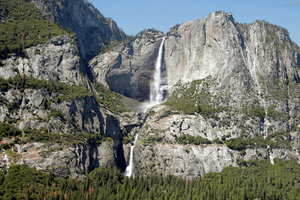The National Parks at 100
Americans agree that these special places hold immense value. But how to pay to preserve them remains a challenge.

Yosemite Falls in Yosemite National Park, Calif., in June 2016.
Joshua Roberts/Reuters
Americans often deeply disagree on what role the federal government should play in their lives. So it’s encouraging to learn that there is one aspect of government that is highly valued by nearly every American: the national parks.
The National Park Service (NPS) celebrates its 100th anniversary Aug. 25. Earlier this summer a new study put an overall value on the more than 400 national parks, monuments, scenic rivers, and historic sites in the NPS system. It asked a representative group of Americans if it was “important to me that National Parks are preserved for current and future generations whether I visit them or not.” Their reply: 94.9 percent agreed.
The survey also asked respondents to say how much extra they would be willing to pay annually in taxes over a 10-year period to ensure the existence of the national parks. The answer: $92 billion. The report went on to note that this “total economic valuation,” as economists call it, was a “conservative” estimate of the parks’ true value.
The figure is also more than 30 times higher than the amount currently being spent on operating the parks each year – about $2.6 billion.
Today the NPS system is hardly a national secret. Documentary filmmaker Ken Burns told its story, including the growing recognition of the parks’ immense national value, in his brilliant 2009 TV documentary series “The National Parks: America’s Best Idea.”
In 2015 alone these parks received some 307 million visits. But they also seem to be caught in an odd juxtaposition: While the national parks are appreciated and highly visited (some argue they are being “loved to death”) they are also woefully underfunded. Some $11.9 billion of needed maintenance is being perpetually delayed, awaiting more funds.
The parks also face new threats, including the effects of climate change. Challenges range from the rapid shrinking of the spectacular glaciers of Montana’s Glacier National Park to the ravaging of the eastern forests of the Great Smoky Mountains, under assault from an invasive Asian insect, the hemlock woolly adelgid. The fish in seemingly pristine Voyageurs National Park in Minnesota have been found to be contaminated with mercury.
It’s too soon to know what the makeup or priorities of the next US Congress will be. But a special appropriation of additional funds for the national parks, perhaps tied to the 100th anniversary of the NPS, would seem likely to win wide public approval.
Efforts to enlist the help of other benefactors, such as private philanthropies, have been under way for many years. The centennial would also be a propitious time for these friends to step up their efforts and for others to join them.
It’s impossible to put a price on the awe-inspiring views of the El Capitan and Half Dome rock formations from the canyon floor in Yosemite National Park, the shouts of excitement as Old Faithful geyser blasts skyward in Yellowstone National Park, or the quiet splendor of watching the first rays of dawn light up Cadillac Mountain in Maine’s Acadia National Park.
The grandeur of America’s national parks is irreplaceable. Once alerted Americans surely will act to preserve them for generations to come.

